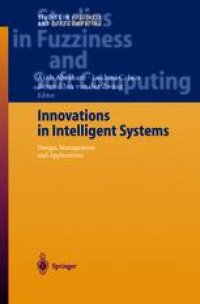
Ebook: Innovations in Intelligent Systems
- Tags: Appl.Mathematics/Computational Methods of Engineering, Artificial Intelligence (incl. Robotics), Computer Imaging Vision Pattern Recognition and Graphics, Computer-Aided Engineering (CAD CAE) and Design, Applications of Mathematics, O
- Series: Studies in Fuzziness and Soft Computing 140
- Year: 2004
- Publisher: Springer-Verlag Berlin Heidelberg
- Edition: 1
- Language: English
- pdf
Innovations in Intelligent Systems is a rare collection of the latest developments in intelligent paradigms such as knowledge-based systems, computational intelligence and hybrid combinations as well as practical applications in engineering, science, business and commerce. The book covers central topics such as intelligent multi-agent systems, data mining, case-based reasoning, and rough sets. Essential techniques to the development of intelligent machines are investigated such as pattern recognition and classification, machine learning, natural language processing, grammar, evolutionary schemes, fuzzy-neural procedures, and intelligent vision. The book also includes useful applications ranging from medical diagnosis and technical/medical language translation, to power demand forecasting and manufacturing plants. Due to its depth and breadth of the coverage and the usefulness of the techniques and applications, this book is a valuable reference for experts and students alike.
Innovations in Intelligent Systems is a rare collection of the latest developments in intelligent paradigms such as knowledge-based systems, computational intelligence and hybrid combinations as well as practical applications in engineering, science, business and commerce. The book covers central topics such as intelligent multi-agent systems, data mining, case-based reasoning, and rough sets. Essential techniques to the development of intelligent machines are investigated such as pattern recognition and classification, machine learning, natural language processing, grammar, evolutionary schemes, fuzzy-neural procedures, and intelligent vision. The book also includes useful applications ranging from medical diagnosis and technical/medical language translation, to power demand forecasting and manufacturing plants. Due to its depth and breadth of the coverage and the usefulness of the techniques and applications, this book is a valuable reference for experts and students alike.
Innovations in Intelligent Systems is a rare collection of the latest developments in intelligent paradigms such as knowledge-based systems, computational intelligence and hybrid combinations as well as practical applications in engineering, science, business and commerce. The book covers central topics such as intelligent multi-agent systems, data mining, case-based reasoning, and rough sets. Essential techniques to the development of intelligent machines are investigated such as pattern recognition and classification, machine learning, natural language processing, grammar, evolutionary schemes, fuzzy-neural procedures, and intelligent vision. The book also includes useful applications ranging from medical diagnosis and technical/medical language translation, to power demand forecasting and manufacturing plants. Due to its depth and breadth of the coverage and the usefulness of the techniques and applications, this book is a valuable reference for experts and students alike.
Content:
Front Matter....Pages i-xxv
Front Matter....Pages 1-1
Use of Multi-category Proximal SVM for Data Set Reduction....Pages 3-20
Bayesian Control of Dynamic Systems....Pages 21-50
AppART: a Hybrid Neural Network Based on Adaptive Resonance Theory for Universal Function Approximation....Pages 51-88
An Algorithmic Approach to the Main Concepts of Rough Set Theory....Pages 89-110
Automated Case Selection from Databases Using Similarity-Based Rough Approximation....Pages 111-130
An Induction Algorithm with Selection Significance Based on a Fuzzy Derivative....Pages 131-149
Model and Fixpoint Semantics for Fuzzy Disjunctive Programs with Weak Similarity....Pages 151-202
An Automated Report Generation Tool for the Data Understanding Phase....Pages 203-219
Finding Trigonometric Identities with Tree Adjunct Grammar Guided Genetic Programming....Pages 221-234
Front Matter....Pages 235-235
Modeling a Distributed Knowledge Management for Autonomous Cooperative Agents with Knowledge Migration....Pages 237-256
Intelligent Information Systems Based on Paraconsistent Logic Programs....Pages 257-283
Neuro-Fuzzy Paradigms for Intelligent Energy Management....Pages 285-314
Information Space Optimization for Inductive Learning....Pages 315-342
Detecting, Tracking, and Classifying Human Movement Using Active Contour Models and Neural Networks....Pages 343-360
Fuzzy Sets in Investigation of Human Cognition Processes....Pages 361-379
A Full Explanation Facility for an MLP Network That Classifies Low-Back-Pain Patients and for Predicting MLP Reliability....Pages 381-411
Automatic Translation to Controlled Medical Vocabularies ....Pages 413-434
A Genetic Programming for the Induction of Natural Language Parser....Pages 435-456
Back Matter....Pages 457-468
Innovations in Intelligent Systems is a rare collection of the latest developments in intelligent paradigms such as knowledge-based systems, computational intelligence and hybrid combinations as well as practical applications in engineering, science, business and commerce. The book covers central topics such as intelligent multi-agent systems, data mining, case-based reasoning, and rough sets. Essential techniques to the development of intelligent machines are investigated such as pattern recognition and classification, machine learning, natural language processing, grammar, evolutionary schemes, fuzzy-neural procedures, and intelligent vision. The book also includes useful applications ranging from medical diagnosis and technical/medical language translation, to power demand forecasting and manufacturing plants. Due to its depth and breadth of the coverage and the usefulness of the techniques and applications, this book is a valuable reference for experts and students alike.
Content:
Front Matter....Pages i-xxv
Front Matter....Pages 1-1
Use of Multi-category Proximal SVM for Data Set Reduction....Pages 3-20
Bayesian Control of Dynamic Systems....Pages 21-50
AppART: a Hybrid Neural Network Based on Adaptive Resonance Theory for Universal Function Approximation....Pages 51-88
An Algorithmic Approach to the Main Concepts of Rough Set Theory....Pages 89-110
Automated Case Selection from Databases Using Similarity-Based Rough Approximation....Pages 111-130
An Induction Algorithm with Selection Significance Based on a Fuzzy Derivative....Pages 131-149
Model and Fixpoint Semantics for Fuzzy Disjunctive Programs with Weak Similarity....Pages 151-202
An Automated Report Generation Tool for the Data Understanding Phase....Pages 203-219
Finding Trigonometric Identities with Tree Adjunct Grammar Guided Genetic Programming....Pages 221-234
Front Matter....Pages 235-235
Modeling a Distributed Knowledge Management for Autonomous Cooperative Agents with Knowledge Migration....Pages 237-256
Intelligent Information Systems Based on Paraconsistent Logic Programs....Pages 257-283
Neuro-Fuzzy Paradigms for Intelligent Energy Management....Pages 285-314
Information Space Optimization for Inductive Learning....Pages 315-342
Detecting, Tracking, and Classifying Human Movement Using Active Contour Models and Neural Networks....Pages 343-360
Fuzzy Sets in Investigation of Human Cognition Processes....Pages 361-379
A Full Explanation Facility for an MLP Network That Classifies Low-Back-Pain Patients and for Predicting MLP Reliability....Pages 381-411
Automatic Translation to Controlled Medical Vocabularies ....Pages 413-434
A Genetic Programming for the Induction of Natural Language Parser....Pages 435-456
Back Matter....Pages 457-468
....